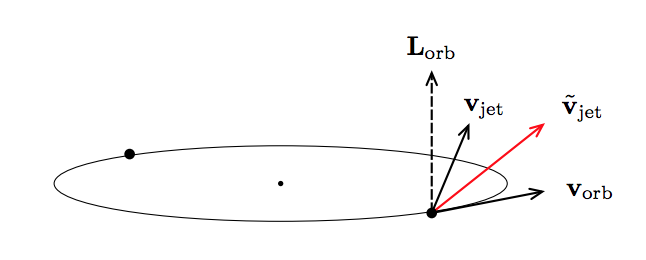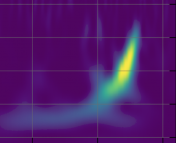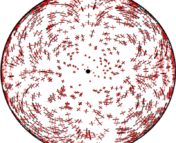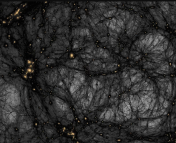- Title: Radio Crickets: Chirping Jets from Black Hole Binaries Entering their Gravitational Wave Inspiral
- Authors: Girish Kulkarni and Abraham Loeb
- First Author’s Institution: Institute of Astronomy and Kavli Institute of Cosmology, University of Cambridge
- Paper Status: Submitted to MNRAS Letters
This November marks the 100th anniversary of Einstein’s Theory of General Relativity (GR), our modern theory of gravity that describes its true nature and intimate connection with space and time. A century after the formulation of GR, one of the phenomena predicted by this theory has remained elusive to detection – ripples of gravitational energy propagating through spacetime like waves. These gravitational waves have remained elusive for good reason.
Spacetime is very stiff, and even extremely massive objects accelerating through spacetime produce feeble gravitational wave signals (so feeble that when Einstein predicted their existence he believed we would never be able to detect their minuscule effects on spacetime). Coincidentally, the centennial year of GR is also when the upgraded and unbelievably sensitive Advanced Laser Interferometer Gravitational Wave Observatory (aLIGO) will commence science runs. This machine is predicted to make the first direct detections of these ripples in spacetime over the next few years and open up a new window to the Universe through multi-messenger astronomy.
Though the first detection of gravitational waves will be more than enough to celebrate about, a true goldmine of scientific wealth will come from finding an electromagnetic counterpart of a gravitational wave signal, allowing these astrophysical objects to be accessed by two completely independent forms of information. Today’s paper considers a possible electromagnetic counterpart of what is thought to be the loudest gravitational wave event in the Universe – the merging of two supermassive black holes (SMBHs). These events would be screaming in gravitational wave radiation, and may be able to reach gravitational wave luminosities of about 10^50 Watts right before they merge. As comparison, this is about as luminous as all the stars shining in all the galaxies in the observable Universe! Though aLIGO is not sensitive to these frequencies of gravitational waves, pulsar timing arrays and future space-based interferometers like eLISA will be.
SMBH binaries are believed to emerge via the collision of two large galaxies, each of which hosting a massive black hole at its center. After the galaxies collide, the SMBHs lose angular momentum through dynamical friction, creeping close enough to the remnant galaxy’s center to form a gravitationally bound binary. After entering their orbital dance, the black holes continue to lose angular momentum by scattering gas and stars, causing their orbit to shrink (though this phase of binary SMBH evolution is up for debate, since theoretical models have a hard time making the orbits shrink when their orbital separation is on the order of 1 parsec, or about 200,000 astronomical units, an issue known as the final parsec problem). When they reach a separation of about 1/1000 parsecs (a couple hundred astronomical units…pretty close given that the event horizon of a billion Solar mass black hole situated at our Sun would stretch 20 astronomical units, or all the way to the orbit of Uranus), gravitational wave emission becomes the key player in angular momentum loss, quickly diminishing the orbital separation until the two SMBHs merge. It is this final phase of orbital evolution that may be probed with future space-based gravitational wave observatories. But alternatively, as today’s paper suggests, we may be able to gain insight about this period of evolution from electromagnetic radiation as well.

Figure 1. The jet and orbital configuration, assuming equal mass black holes. L_orb is the orbital angular moment, v_jet is the velocity of the jet without orbital motion, v_orb is the orbital velocity, and the red vector v~jet is v_jet + v_orb. v~jet precesses about v_jet as the black hole orbits. Figure 1 in the paper.
The key to the electromagnetic counterpart presented in today’s paper is that the black holes are able to hold onto an accretion disk and continue accreting gas during this gravitational wave dominated stage of orbital evolution, shown to be possible in recent studies. With accretion disks come jets of highly relativistic particles, and charged particles spiraling in the strong magnetic field of a SMBH emit synchrotron radiation detectable by radio telescopes. As the binary orbits, the jet will trace out a conical surface. This is easily seen by looking at figure 1 and recalling simple vector addition (remember, for an observer very far away, the solid black jet vector, which represents the velocity of the jet neglecting orbital motion, is essentially fixed, while the orbital velocity vector is constantly changing). The red jet vector, which is the combination of both the jet velocity and orbital velocity, therefore precesses about the black jet vector as the black hole orbits. This would be the end of the story if these binaries were not emitting gravitational waves.
Since the system emits gravitational waves during this phase, the orbital separation decreases, causing the orbital speed to increase. Imagine the black orbital velocity vector from figure 1 increasing. The red vector, which is the sum of the orbital and jet velocities, will therefore have an increasing contribution from the orbital velocity, causing it to precess about the black jet vector with an increasing opening angle. The increase in orbital speed and decrease in orbital separation of the binary will also cause the jet to precess faster, winding the jet tighter closer to the source and resulting in a classical “chirping” morphology in the jet (hence the “radio crickets” in the title of this bite). These effects can be seen in figure 2, which simulates the evolution of a SMBH jet during the first 100 years after entering the gravitational wave dominated regime of orbital decay.

Figure 2. The jets of an equal-mass binary with a total mass of 10 billion solar masses situated 100 megaparsecs away. The axes are angular size in milli-arcseconds. The left panel shows the bipolar jet pointed toward and away from the observer on the right and left of the box, respectively. The opening angle of the jet increases as one gets closer to the black hole, as this represents material emitted later in time. Also apparent is the chirping morphology; as one gets closer to the source the helicity increases because the orbital frequency increases. The twisting of the jet is due to apparent superluminal motion. The right panel shows the normalized brightness of the inner 30 milli-arcsecond region of the forward jet. Figure 5 in the paper.
Long baseline radio interferometry from telescope arrays such as the Square Kilometer Array, set to have its first light in 2020, will achieve the resolution necessary to observe these subtle milli-arcsecond jet features caused by gravitational wave inspiral. These observations would also put a lower bound on the abundance of bright gravitational wave sources detectable by future space-based detectors. Moreover, supplementing gravitational wave observations with electromagnetic observations of compact binary mergers will enable detailed studies on the strong-field regime of GR, where Einstein’s theory of gravity might break down and create problems that need to be solved by future generations of scientists.




